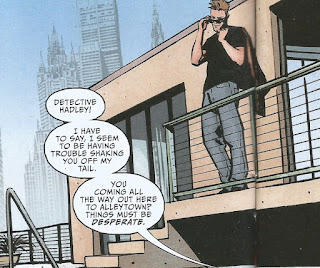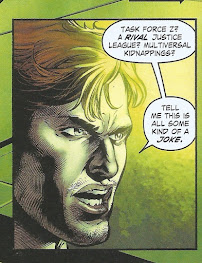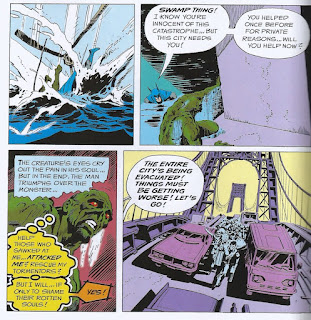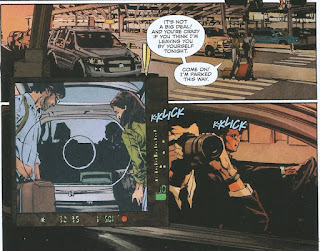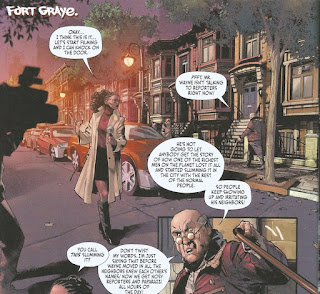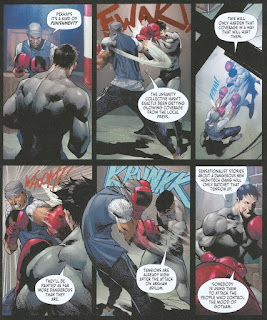Pick of the Brown Bag
March 14, 2021
by
Ray Tate
Welcome back to the first POBB marathon spotlighting the Infinite Frontier. For this posting, I look at The Crime Syndicate, Suicide Squad and Swamp Thing. If you're out of time and need a snap decision-- #PickoftheBrownBag --on Twitter.
Gotta admit. It takes balls to write the Crime Syndicate after Grant Morrison and Geoff Johns.
Created by Gardner Fox and Mike Sekowsky, the Crime Syndicate of America debuted in Justice League of America #29 in 1964.
The Crime Syndicate was unlike any other group of villains the Justice League faced. That was because they were the top dogs of Earth-Three.
Earth-Three is a distinctive mirror earth where several opposites in history occur. I won't go into details because you can only make sense of them after some deep, deep thought.
Originally, the changes were just flip and superficial like Lincoln shooting President Booth. When you ponder though, the Crime Syndicate's entire timeline must be radically different.
At the onset, the Crime Syndicate bore no doppelgänger relationships to the Justice League. In other words the villainous Johnny Quick was not secretly John Chambers, nor Barry Allen nor any of the other Flash Family of speedsters. These villains merely mocked the colors and style of the Justice League.
The original Crime Syndicate returned to plague the Justice League and the Justice Society several times before dying in The Crisis on Infinite Earths. Since the multiverse no longer existed. Neither could the Crime Syndicate. Then, Grant Morrison happened.
Morrison began recreating the multiverse in JLA. The Justice Society were in metaphorical limbo. Earth Two was vacant. It became the Syndicate's new home.
Again, these reconfigured villains are nobody we know. Ultraman isn't Kal-El. Superwoman though adopting the identity Lois Lane is actually an Amazon just like her predecessor. Owlman is Thomas Wayne Jr.
Geoff Johns for the New 52's Forever Evil preserved a lot of what Grant Morrison reconstituted, He furthermore added a clever purloined letter in the form of Atomica, a female, gun-moll version of the Atom. By the by, Johns' sleight of hand plotting in this event is his most masterful.
Andy Schmidt's story presents the formation of the latest version of the Crime Syndicate, resurrected from Death Metal. I know as much about Death Metal as I do the Suicide Squad. Let's just say something happened to reboot the multiverse and move on.
The book opens on the JFK assassination, but it's somewhat different than what you expect.
A lot of people are going to accuse the Crime Syndicate of ripping off Brightburn. Sorry. Ultraman was Brightburn long before Brightburn. No matter the incarnation, the Syndicate were always a nasty bunch of bastards.
The elimination also exemplifies the unique history of the Syndicate's planet. That incarnation of JFK was an authoritarian dictator. People cheer after the assassination, until they see what did the deed.
This version of Earth-Three may not have stayed rancid like the previous copies. We jump forward to the now, where Cat Grant runs The Daily Planet.
A long time ago, post-Crisis creation Cat Grant was just a reporter of fluff pieces. As writers started giving her dignity and depth, she evolved into a substantial character, making her transition to founder of media conglomerate Catco on Supergirl a linear, short step.
Cat editing and publishing the Daily Planet has only been a polar opposite for a few brief formative years. The real strange thing about the scene is that on a corrupt Earth-Three, newspapers exist and still print the truth.
Other Syndicate members get their piece and highlight the unsual nature of the earth they occupy.
Oliver Queen became President. Superwoman in this story is an evil version of Donna Troy. I doubt Schmidt would have thought of that if not for Dan Abnett's remarkable Titans run.
The post-Crisis repeatedly kicked Donna Troy in the teeth. She suffered greatly from having her history ripped out from under her. More so than her fellow Titans. The New 52 hasn't been any kinder.
At first rewritten as a homunculus fashioned to kill Wonder Woman, Donna experienced a fuzzy memory composite of her previous Teen Titans life. Rejoining the Titans, she learns her future self will conquer the planet and murder not just Wonder Woman but every other hero. Sucker...It was Wally West all along.
Adding to the roster, Schmidt revives Crime Syndicate also-rans like the new Johnny Quick who looks like a refugee from Mad Max Fury Road. We also get a new Atomica and a new John Stewart as Power Ring.
A new ring of Volthoom, as well. The New God Black Racer destroyed the evil intelligence in Justice League during the Darkseid War. Another really good Geoff Johns production.
Last but not least, Owlman shows up toward the conclusion, being part Morrison Hoots and part Scott Snyder Court of Owls.
The Crime Syndicate forms this time to combat an invasion by Starro the Conqueror. Starro first attempted to conquer earth-one back in the Silver Age. He shows up every once and awhile for a repeat performance, heckled by the League. He's an A-Class threat even if thwarted by a mascot with a snapping fetish and worth the Syndicate's mettle. Still there's nobody here to root for.
Starro's a cunning alien, monster. The Syndicate are evil. Schmidt raises them above the level of ordinary criminal. They all foster different rationales for fighting Starro, and becoming sort of champions of the innocent by default. Still, evil though.
Art by Kieran McKeown and Dexter Vines offers a solid visual narrative filled with emotive characters, and Steve Oliff's hues add zing. This is about as colorful a comic book reveling in villainy can get. Subscribe if you're a Crime Syndicate fan. Follow for possible hero guest stars if you're not.
So, guess what? I know beans about the history of the Suicide Squad. I know that the original team were a handful of expendable, human operatives led by Rick Flagg, and that's about it. So click on the wikipedia link if you're super-interested. I'm not even mildly curious.
The basics of the modern Suicide Squad is simple. Amanda Waller controls a team of expendable villains and sometimes heroes from the DC Pantheon to handle tasks too dirty for higher grade Leaguers, Legionnaires, Titans, and sure, even Outsiders. The carrot is usually a reduced sentence. The stick is a remote control explosive device in the head or neck. You only get hit once with the stick.
Usually, I don't give a rat's behind about the Suicide Squad. I agree with Batman, who despises Waller and the Squad. However, Charlton cover heroes Peacemaker and the Judomaster, of all people, make picking up at least one issue difficult to resist.
This is not to say Judomaster or Peacemaker are favorite characters, or even good characters. I've never read a single one of their original adventures. Nevertheless, I'm aware of their existence and that DC bought these oddities as part of a birthday gift for Dick Giordano. True. It's their rarity that makes them sauce for the goose. Dan Greenwald from the Comic Book Pit podcast referred to such figures as stray puppies. I've not heard of a better description.
Suicide Squad didn't change my uninformed opinion of Judomaster and Peacemaker. Marvel cornered the market in super-cool martial artists in the seventies at the height of the Kung-Fu Fighting era.
DC has the Batman Family and Black Canary. Why on earth would I waste my time on some lame "master" of judo? Ever hear of the original Black Cat from the humble Harvey Comics?
That's some tastier eye-candy, let me tell you, and I'm sure she can kick Judomaster's ass. Of course, so can Tinker from Speedy Buggy.
As for Peacemaker, what the hell is up with that headgear? How? Why?
So this is the Infinite Frontier Suicide Squad. Two Charltons, Bolt, who I know from Who's Who in the DC Universe? All led by Amanda Waller, of course.
Here's the funny thing. I still don't give a rat's behind about the Suicide Squad. I'm either still neutral or disdainful toward this particular team. However, writer Robbie Thompson makes The Suicide Squad compelling.
Amanda Waller is a paranoid lunatic control freak. She believes that every hero she cannot command is her enemy. This includes the Justice League.
That's Rick Flagg. A character who lived far beyond his expected sell date. The Squad's objective.
Infiltrate Arkham Asylum, and that's really all I can say about the book without giving away all the intriguing twists and turns. Somehow Amanda Waller believes these actions will create a countermeasure to the Justice League. She's setting herself up for another loss. Waller should retire somewhere and take up Buddhism. She's just a delusional, ball of hate. In the real world, if she weren't Black, she'd be a pundit on Fox News.
One other impressive thing I can divulge about Suicide Squad. It's actually set before some of the events in the anthology Infinite Frontier, and links up smoothly.
The release of Joker gas catalyzes the Batman story in Infinite Frontier. So, extra points for that.
DC gave the thankless task of making nobodies look good to Eduardo Pansica, Julio Ferreira and Marcelo Majolo. They all measure up to the challenge, and sisters and brothers they were challenged. If you're keen on the Suicide Squad, subscribe. I'll be honest I'm tempted to pick up a second issue. At the very least, follow.
My favorite Catwoman writer Ram V introduces a new Swamp Thing, kind of, to the Infinite Frontier. Will it take root? Damn good question, and it's too early to tell.
Being a fan of Swamp Thing, I'm naturally a little leery of the whole exercise. I'm an old school kind of guy.
Swamp Thing for me is Alec Holland, who's slain in a lab explosion, splashed with a bio-restorative formula of his own invention that merges him with the swamp and extinguishes his flaming body.
Alec spends the rest of the series seeking revenge for his wife Linda whom the opposition murders in cold blood. He actually doesn't want a pound of flesh for his own fate. Killing Linda is the crime. Hence, Swamp Thing's initial success. Alec Holland is selfless. Most people would be pretty raw about being turned into a muck monster. For Alec, all that matters is making the people who killed Linda pay.
After the vengeance, Swamp Thing becomes a fringe figure in DC Comics stopping the monsters, both human and otherwise that threaten humanity and nature.
My very first encounter with Swamp Thing
The Brave and the Bold #122
In the post-Crisis, Swamp Thing became something else. I'm cognizant of Alan Moore's run. I wasn't a huge fan, but I respect it. Moore created a lot of continuity; including the idea that Alec Holland never really was Swamp Thing. Rather the bog plants duplicated Alec's mind. Alec's corpse still lies at the bottom of the lake. Or something like that. Honestly, I never understood any of this. I'm a hard science kind of guy. Moore furthermore originated the idea of Swamp Thing not being one creature. Multiple Swamp Things exist throughout earth's history. I presume it's only earth's history. So, there's a germ that somebody else can be Swamp Thing. Enter Levi Kamei.
Ram V's story is very literate and reads like the opening of a novel rather than a typical comic book. The unsettling mood differs strongly from the bouncy pulpy Catwoman. Mike Perkins' artwork leans into the idea that you're going to be experiencing a work of horror set in the real world.
The Pale Wanderer is Ram V's cryptozoic conception, steeped in folklore. He's a combination of Wendigo, Skunk Ape and Chupacabras. We see the Wanderer's origin story related as a legend by the officer who first broached the subject and later meet the thing in detail.
The incident with the Pale Wanderer juxtaposes with the unfolding of Levi Kamei's transformation into a new Swamp Thing. The first stage occurs in dreams of an uncontrollable germination, but this is only the setup. A suspenseful foreshadowing one may find in The Night Gallery or Sixth Sense. The Gary Collins television series not "I see dead people." The setting of the plane may be homage to The Twilight Zone.
Levi travels to New York to reacquaint himself with a friend, and the plot thickens in a very unexpected way.
Even if Levi becomes the new Swamp Thing, it doesn't explain who is photographing him, or why. Do they have anything to do with Swamp Thing, or is this a tail of Levi the human, not who he will become? So many puzzles. I found Swamp Thing to be tantalizing. Subscribe.





